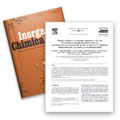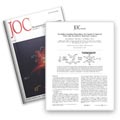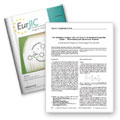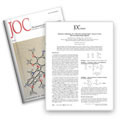contents
publications and posters
- Inorg. Chim. Acta (2007)
- Inorg. Chem. (2007)
- J. Org. Chem. (2006)
- Eur. J. Inorg. Chem. (2004)
- J. Org. Chem. (2004)
- Poster 4 (IPS-16, 2006)
- Poster 3 (EuroChem, 2005)
- Poster 2 (IPS-15, 2004)
- Poster 1 (Warwick, 2002)
see also
This page dresses up a short summary of my works in Chemistry, I wish you to be as interested as I am!
Ph.D. in Molecular Chemistry
and Physical Chemistry
Next to my DEA study year (equivalent of Master’s degree second year), I obtained a thesis grant that allowed me to achieve a Ph.D. in Molecular Chemistry and Physical Chemistry at the SESAMES school of Doctors. This school brings together the research units of both University Henri Poincaré (Nancy, France) and University Paul Verlaine (Metz, France), thus representing multiple areas of Chemistry.
Thesis

Modulation of ruthenium complexes properties through pyrrole or pyrrolidine substituted polypyridine ligands:
toward new sensitizers for the photovoltaic
Defended on October 13, 2006
Abstract
The promotion of solar energy conversion is challenging the development of energy sources to replace fossil fuels. In this area, Dye-sensitized Solar Cells (DSC) appear to be promising devices. Operation principle relies on the photosensitization of a wide-gap semiconductor with a dye, the latter typically being a polypyridinyl ruthenium(II) complex. Modulation of the properties of such complexes enables the optimization of the corresponding solar cells’ performances.
In the present work, we synthesized and investigated the effect of new ligands substituted by the electron-releasing pyrrole or pyrrolidine. These moieties induce, in homoleptic, bis- and tris-heteroleptic Ru(II) complexes, red-shifts of the absorption spectra and rises of the molar extinction coefficients. This gives evidence of sunlight harvesting enhancement. The photo-response (IPCE) of the corresponding sensitized cells strongly depends upon electrolyte’s composition. The best results were obtained with cobalt-containing mediators.
Meanwhile, breakthrough advances were carried out toward the setup of solid-state solar cells with a polypyrrole matrix.
Keywords:
regioselective lithiations, nitrogen-containing ligands, ruthenium complexes, electronic effects, photophysic, electrochemistry, photosensitization, dye, solar cell, DSC, IPCE
Examination committee:
- Nelly Plé, Professor at the University of Rouen (referee)
- Hubert Le Bozec, CNRS Research Director at the University Rennes 1 (referee)
- Jean-Pierre Sauvage, CNRS Research Director at the University Louis Pasteur - Strasbourg 1 (reviewer)
- Yves Fort, Professor at the University Henri Poincaré - Nancy 1 (reviewer)
- Carlo A. Bignozzi, Professor at the University of Ferrara, Italy (invited member)
Directors:
- Philippe Gros, CNRS Research Director at the University Henri Poincaré - Nancy 1
- Marc Beley, Professor at the University Paul Verlaine - Metz.
Publications

Dye-Sensitized Solar Cells based on PEDOP as a Hole Conductive Medium
Stefano Caramori, Silvia Cazzanti, Luca Marchini, Roberto Argazzi, Carlo Alberto Bignozzi, David Martineau, Philippe C. Gros and Marc Beley
Inorganica Chimica Acta 2008, 361(3), 627-634
[DOI : 10.1016/j.ica.2007.04.016]

Tuning of Ruthenium Complex Properties Using Pyrrole- and Pyrrolidine-Containing Polypyridine Ligands
David Martineau, Marc Beley, Philippe C. Gros, Silvia Cazzanti, Stefano Caramori, and Carlo A. Bignozzi
Inorg. Chem. 2007, 46(6), 2272-2277
[DOI : 10.1021/ic062042f]

Pyrrolidine-Containing Polypyridines: New Ligands for Improved Visible Light Absorption by Ruthenium Complexes
David Martineau, Marc Beley, and Philippe C. Gros
J. Org. Chem. 2006, 71(2), 566-571
[DOI: 10.1021/jo051994k]

New Ruthenium Complexes with 4-(1H-Pyrrol-1-yl)-Substituted Polypyridine Ligands. Electrochemical and Spectroscopic Properties
David Martineau, Philippe Gros, Marc Beley, and Yves Fort
Eur. J. Inorg. Chem. 2004, 20, 3984-3986
[DOI: 10.1002/ejic.200400385]

Selective Lithiation of 4-(1H-1-Pyrrolyl)pyridine. Access to New Electron-Releasing Ligands
David Martineau, Philippe Gros, and Yves Fort
J. Org. Chem. 2004, 69(23), 7914-7918
[DOI: 10.1021/jo0496244]
And one more paper to come...
Posters

Investigation Of New Electron-Releasing Ligands In Ruthenium Sensitizers For DSC Appliance
David Martineau, Marc Beley, Philippe Gros, Stefano Caramori, Silvia Cazzanti, Carlo Alberto Bignozzi
Poster presented during the International Conference on Photochemical Conversion and Storage of Solar Energy (IPS-16) 2006, Uppsala, Sweden.
[PDF: Poster 4 1.1 MB]

New electroreleasing ligands for the photosensitisation of Ruthenium
David Martineau, Marc Beley, and Philippe Gros
Poster presented during the SFC-EuroChem Nancy-2005 congress, in addition to the oral communication awarded in the “Photoactive Species and NLO” symposium.
[PDF: Poster 3 464 kB]

Synthesis of novel bipyridine and terpyridine ligands for the preparation of photoactive complexes
David Martineau, Philippe Gros, and Marc Beley
Poster presented during the International Conference on Photochemical Conversion and Storage of Solar Energy (ISP-15) 2004, Paris, France.
[PDF: Poster 2 2.1 MB]
Master 2 (DEA)
During the year 2002-2003, I did a DEA study year (equivalent of Master’s degree second year) of molecular chemistry and physical chemistry in the SOR laboratory at the University Henri Poincaré (Nancy, France). This laboratory is directed by Prof. Yves Fort and develops new methods for fine organic and organometallic chemistry, syntheses of biologically active molecules, and designs new molecular materials. Some of the works carried in the laboratory concern regio- and chimio-selective lithiations methods on π-defective compounds with new concepts of lithiated bases’ activation.
The works I carried out consisted in setting up a new method for the regio-selective functionalisation of the 4-pyrrolylpyridine pattern using sequential lithiations with the super-basic aggregated system BuLi-LiDMAE that is developped for several years in the laboratory. Mono- and difunctional precursors that could have been resultantly prepared allowed us to obtain new bipyridine and terpyridine ligands having an intreresting electro-releasing behavior for photosensitization of Ruthenium.

Fonctionnalisation sélective de la 4-(1H-pyrrol-1-yl)pyridine :
accès à de nouveaux ligands pour la photosensibilisation du Ruthénium
David Martineau, Philippe Gros, Marc Beley and Yves Fort
DEA thesis.
Master 1
My Master’s degree in chemistry at the University Henri Poincaré gave me the opportunity to realize a training period in the UK at the University of Warwick. Prof. David M. Haddleton and his team welcomed me in the Polymer Group laboratory in which hight-level researches are carried out on polymerisation controlled trough ATRP. These works give access to the synthesis of many different polymers having a hight degree of sophistication such as block copolymers, star polymers and dendrymers, and enable the development of environmentally friendly processes which are viable on the commercial scale.
This was for me an occasion to get familiar with organometallic catalysis, polymer synthesis via ATRP, and analysis methods for macromolecules. My works focussed on the incorporation of fluorescent tags in polymers trough copolymerisation as well as by functionalising polymers previously prepared. This fluorescent markup would enable tracking in-vivo the polymers used for medical treatments of stomach or intestinal diseases.

Incorporation of fluorescent tags in polymers
David Martineau, Dr. Adrian Carmichael, and Prof. David M. Haddleton
Master’s degree training period assessment.

Incorporation of fluorescent tags in polymers
David Martineau, Dr. Adrian Carmichael, and Prof. David M. Haddleton
Poster presented to the Macro Group UK International Symposium on Polymer Synthesis - Warwick 2002
[PDF: Poster 1 3.7 MB]
Undergraduate Studies
After I passed my Baccalauréat Sciences, "Physic and Chemistry" option (equivalent of the British A-Levels or US High School graduation), I went to the University Henri Poincaré in Nancy (France) from 1998 to 2000 and obtained the Material Sciences DEUG (two years post A-Levels). The next year, in 2001, I passed my Licence of Chemistry with organic chemistry speciality (equivalent to Bachelor’s degree).

